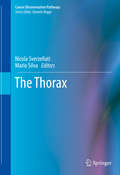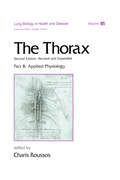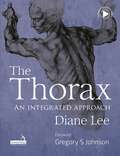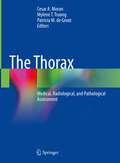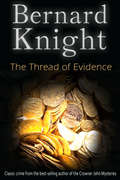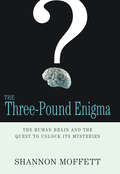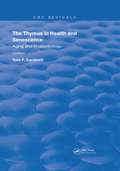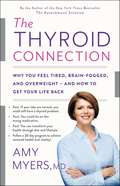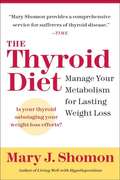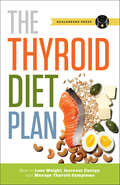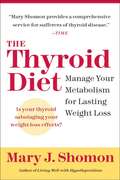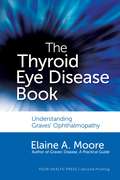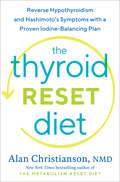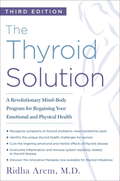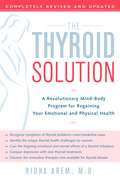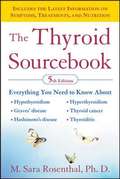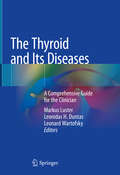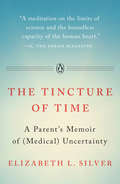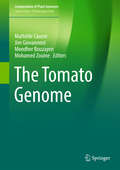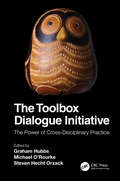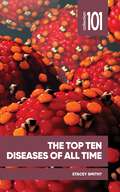- Table View
- List View
The Thorax (Cancer Dissemination Pathways)
by Nicola Sverzellati Mario SilvaThis book highlights the differences, in terms of neoplastic dissemination pathways, between various types of thoracic cancers. It presents and discusses a comprehensive schematic overview of tumors of the lung parenchyma, of the mediastinum, of the pleura, and of the chest wall. For each tumor, it details the local spread and the lymphatic and vascular dissemination, and it describes the challenging staging of lung tumors with mutations. Illustrations and artwork enrich the content and help readers to understand and visualize tumor spread. The book is of great interest to professionals involved in the study, diagnosis and treatment of thoracic pathologies, as well as to residents in radiology, oncology and pulmonology.
The Thorax -- Part A: Physiology (In Three Parts), Second Edition (Lung Biology in Health and Disease)
by Charis RoussosThis book provides a comprehensive, authoritative, and contemporary discussion of the physiology and pathophysiology of the chest wall as well as an overview of the diagnostic and therapeutic modalities. It is an invaluable aid to clinical investigators.
The Thorax, ---Part B: Applied Physiology (In Three Parts)
by Charis Roussos Theodoros VassilakopoulosThis timely Second Edition of a landmark reference furnishes in-depth examinations of the latest developments in the physiology, pathophysiology, and clinical relevance of the respiratory muscles and chest wall-reflecting the explosion of information that has occurred since the publication of the previous edition.
The Thorax: An integrated approach
by Catherine Ryan Diane Lee Nancy Keeney SmithThis clinical textbook will update the reader on the relevant anatomy, known biomechanics, clinical assessment, musculoskeletal conditions and treatment of the thorax and how these relate to the function of the whole body. An integrated biopsychosocial model (the Integrated Systems Model - ISM) will be highlighted in this text and used as a foundation for clinicians to organize their knowledge from multiple sources. The text emphasizes the current suggestion from the evidence that treatment be individualized and that clinical reasoning form the basis for treatment decisions.Richly illustrated with 3D-rendered colour anatomical drawings, and over 250 clinical photographs, The Thorax: An integrated approach is the definitive manual on the thorax for all bodyworkers helping patients improve mobility and control of the trunk.
The Thorax: Medical, Radiological, and Pathological Assessment
by Cesar A. Moran Mylene T. Truong Patricia M. de GrootThe current medical practice has become more of a team effort rather than an isolated practice. The current evaluation of patients in the daily practice is essentially performed by medical assessment of the patient in question followed by diagnostic imaging, and when needed and possible the evaluation of tissue for diagnosis with its subsequent assessment of biomarkers and other ancillary tools that play an important role in the evaluation and prognosis. The book herein proposed will exactly provide such assessment focused in the thoracic assessment of patients afflicted with any particular disease of the thorax. Expert clinician in pulmonary medicine will provide the state of the art in the evaluation of such patients, which will provide the most important background in the clinical impression and further assessment of these patients. This assessment in most cases is followed by the evaluation of imaging, which provides a highly important information of not only the exact location of the process but also of the nature of whether is localized, infiltrative, diffuse, bilateral, etc., as well as the possible compromise of other adjacent structures. Such information is crucial as imaging and clinical information will provide a working diagnosis, which ultimately will be defined by the pathological assessment. Therefore, in real practice neither one of these subspecialties works alone or in isolation. On the contrary, each one depends on the other for the final diagnosis and proper management of patients with thoracic diseases. Based on such experience is that the current text will provide in the same text of the needed information that a clinician, radiologist or pathologist will need in order to arrive to the best possible conclusion. The scope of this book is unique in its nature as currently, even though there are several text on either one of those specialties, those publication are strictly on the either radiology, medicine or pathology. Our proposed text will bring all those together in a single text and written by experts in their respective field. This book should be of interest to all of those in the practice of thoracic medicine (radiologist, pulmonologist, pathologists) and any one who in the general practice is confronted with the evaluation of these patients.
The Thread of Evidence: The Sixties Crime Series (The\sixties Crime Ser. #2)
by Bernard KnightA classic murder mystery by acclaimed author Bernard Knight.When some boys find a human bone in a cave in Cardiganshire, Wales, a case that has gone unresolved for over thirty years suddenly springs back into life. For that grisly find is only the start of things...When the rest of the skeleton is soon discovered, the disappearance of a local woman decades earlier comes back to public attention. The woman’s husband has recently returned to the area after years out of the country, and he has no explanation as to why his wife suddenly went missing. The local gossips consider him guilty of murder, as do some in the police force…but not everyone is convinced. It’s up to Superintendent Pacey to work out which bits of the whole sorry tale are fact and which are fiction – and there are some unpleasant surprises along the way…
The Three-Pound Enigma: The Human Brain and the Quest to Unlock Its Mysteries
by Shannon MoffettThe average human brain weighs three pounds—80 percent of which is water—and yet it's capable of outstripping the computational and storage capacities of the most complex computer. But how the mind works remains one of humankind's greatest mysteries. With boundless curiosity and enthusiasm, Shannon Moffett, a Stanford medical student, takes us down the halls of neuroscience to the front lines of cutting-edge research and medicine to meet some of today's most extraordinary scientists and thinkers, all grappling with provocative questions: Why do we dream? How does memory work? How do we see? What happens when we think? Each chapter delves into a different aspect of the brain, following the experts as they chart new ground. Moffett takes us to a lab where fMRI scans reveal the multitude of stimuli that our brains unconsciously take in; inside an operating room where a neurosurgeon removes a bullet from a patient's skull; to the lab of Christof Koch, a neuroscientist tracking individual neurons in order to crack the code of consciousness; and to a research lab where scientists are investigating the relationship between dreams and waking life. She also takes us beyond the scientific world—to a Zen monk's zendo, where she explores the effects of meditation on the brain; inside the home of a woman suffering from dissociative identity disorder; to a conference with the philosopher Daniel Dennett, who uses illusions, magic, tricks, and logic to challenge our assumptions about the mind; and to the home of the late Nobel Laureate Francis Crick, co-discoverer with James Watson of DNA's double-helix structure. Filled with fascinating case studies and featuring a timeline that tracks the development of the brain from conception to death, The Three Pound Enigma is a remarkable exploration of what it means to be human.
The Thymus in Health and Senescence: Volume 2 Aging and Endocrinology (Routledge Revivals #2)
by Nathan F. CardarelliFirst published in 1989: This text was written to provide a relatively broad comprehensive study of the thymus in health and disease, including relationships to the endocrine system, immue system, and again.
The Thyroid Connection: Why You Feel Tired, Brain-Fogged, and Overweight -- and How to Get Your Life Back
by Amy MyersFrom the author of the New York Times bestseller The Autoimmune Solution, a comprehensive, accessible overview of thyroid problems that will help you learn to identify the warning signs and finally take back your health.Are you exhausted all the time, plagued by brain fog, and unable to lose weight? Do you struggle with insomnia, panic attacks, and tremors? But does your doctor insist that your labs are normal, and that you just need to eat less and exercise more? As anyone who has been there knows, nothing is more frustrating, stressful, and emotionally draining than feeling unwell and being told you're fine by the very person who is supposed to heal you. The truth is, your symptoms could be caused by a thyroid disorder--the hidden cause behind a wide array of health problems that can threaten to ruin your life. Thyroid dysfunctions like Hashimoto's disease, hypothyroidism, and hyperthyroidism affect at least 20 million Americans and yet conventional medicine frequently misses the diagnosis. The scariest part? Most doctors won't even order thyroid tests unless you specifically ask. Now, in The Thyroid Connection, Dr. Amy Myers teaches you how to take your health into your own hands. Dr. Myers, originally misdiagnosed herself, understands the struggles of thyroid dysfunction firsthand. Fortunately, she also knows how achievable recovery and well-being are, and just how to get you there. In The Thyroid Connection, she explains the science behind thyroid problems, as well as how to work with your doctor to ensure proper diagnosis and treatment. Complete with a 28-day action plan tailored to your specific condition, along with advice on diet and nutrition, supplements, exercise, stress relief, and sleep, The Thyroid Connection is the ultimate roadmap back to your happiest, healthiest self.
The Thyroid Diet
by Mary J. ShomonFrom patient advocate Mary Shomon, author of Living Well With Hypothyroidism, here is the first book to tackle the weight factors specific to thyroid patients and detail a conventional and alternative plan for lasting weight loss.An estimated 10 million Americans have been diagnosed with thyroid disease--most of them women--and for the majority of them, losing weight is mentioned time and time again as a primary concern and chief frustration--a challenge made more difficult due to the metabolic slowdown of a malfunctioning thyroid gland. For these thyroid patients, treatment alone doesn't seem to resolve weight problems. Further, they may struggle with raising basic metabolism, resolving underlying nutritional deficiencies, treating depression and correcting brain chemistry imbalances, reducing stress, and combating insulin resistance.The Thyroid Diet will identify these factors that inhibit a thyroid patient's ability to lose weight, and offer solutions--both conventional and alternative--to help. It will discuss optimal dietary changes, including how a thyroid sufferer should focus on a low-glycemic, high-fibre, low-calorie diet, eaten as smaller, more frequent meals to balance blood sugar. The Thyroid Diet addresses the use of various herbs, nutritional supplements, and prescription weight loss drugs, outlining the necessity of exercise, and drawing together all information into an integrated diet and exercise plan. It contains several different eating plans, food lists, and a set of delicious and healthy gourmet recipes. With handy worksheets to use in weight loss tracking, and a special resource section featuring websites, books, and support groups, here is vital help for the millions of thyroid patients dealing with weight problems.Mary Shomon has been praised by doctors around the country for her medical knowledge and sensitivity to patients' needs. She will be receiving similar blurbs for this new book. There are no other books on controlling your weight problems if you have a thyroid condition, yet over 40% of overweight people have evidence of a thyroid condition, and the weight loss problems facing them are unique and need a specific approach.
The Thyroid Diet Plan: How to Lose Weight, Increase Energy, and Manage Thyroid Symptoms
by Healdsburg PressMore than 59 million Americans suffer from a thyroid condition, which can severely hinder metabolism and stand in the way of weight loss.The Thyroid Diet Plan can help you manage the symptoms of thyroid disease with a smart diet plan that is actually enjoyable and easy to follow. Whether you have been suffering for years or you were recently diagnosed, The Thyroid Diet Plan can help you boost your metabolism, lose weight, and improve your overall well-being. Combined with exercise and hormonal treatment as recommended by your physician, the delicious recipes found in The Thyroid Diet Plan is the healthy way to reverse your symptoms and feel better right away.The Thyroid Diet Plan will make it easy to lose weight and boost metabolism with:100 delicious and easy-to-follow recipes for every meal of the day* 30-day thyroid diet plan to make managing thyroid disease simple and painlessA detailed checklist of foods to avoid and foods to enjoyQ&A to help you recognize the common symptoms of thyroid diseaseAdvice on toxins, exercise, and sensible weight lossOnce you start The Thyroid Diet Plan you'll be on your way to feeling more energetic, less anxious, and more in control of your thyroid condition.
The Thyroid Diet: Manage Your Metabolism for Lasting Weight Loss
by Mary J. ShomonIs an undiagnosed thyroid condition causing you to pack on the pounds? For more than 25 million Americans it may be due to the metabolic slowdown of a malfunctioning thyroid gland. The Thyroid Diet will help many previously unsuccessful dieters get diagnosed and treated -- and proper thyroid treatment might be all that's needed to successfully lose weight. Even after optimal treatment, however, weight problems plague many thyroid patients. For those patients, The Thyroid Diet will identify the many frustrating impediments to weight loss, and offer solutions -- both conventional and alternative -- to help. Discussing optimal dietary changes, thyroid-damaging foods to avoid, and metabolism-supporting herbs and supplements, it contains several different eating plans, food lists, and a set of delicious and healthy gourmet recipes. With handy worksheets to use in weight-loss tracking and a special resource section featuring Web sites, books, and support groups, here is vital help for millions.
The Thyroid Eye Disease Book
by Elaine A. MooreA definitive guide on Thyroid Eye Disease (TED), more specifically referred to as Graves' Ophthalmopathy (GO). The Book describes all facets of thyroid eye disease, including: genetic, environmental and lifestyle factors that contribute to GO; signs, symptoms; diagnostic tests; conventional and complementary treatment options, with an emphasis on the role of self-care; complications; psychosocial issues of living with GO.
The Thyroid Reset Diet: Reverse Hypothyroidism and Hashimoto's Symptoms with a Proven Iodine-Balancing Plan
by Dr. Alan ChristiansonA surprising new plan to reverse the symptoms of thyroid disease by reducing excess dietary iodine, from integrative physician and New York Times bestselling author Dr. Alan Christianson.&“The most innovative treatment plan around.&”—JJ Virgin, New York Times bestselling author, celebrity nutrition expert, and Fitness Hall of FamerThough the thyroid gland is small, it produces hormones that control the rate of nearly every chemical reaction in the body—turning food into energy, controlling the rate of tissue growth, stimulating the activity of other hormones, and much more. An estimated twenty million Americans have some form of thyroid disease, and up to 60 percent of them are unaware of their condition. Depending on the type and severity of the thyroid disease, symptoms can range from weight gain and fatigue to hair thinning and memory loss. In The Thyroid Reset Diet, Dr. Alan Christianson helps readers reverse chronic thyroid diseases like hypothyroidism and Hashimoto&’s Thyroiditis with nothing more than dietary change: the reduction of iodine intake. Backed by new research showing that proper dietary iodine intake can start to reverse thyroid disease in as little as four weeks, his diet plan contains the optimal amount of iron and dietary iodine to control thyroid hormones, effectively resetting the thyroid. Instead of following a restrictive diet for thyroid health, The Thyroid Reset Diet does not require eliminating any food category. Instead, Dr. Christianson recommends food swaps like brown rice instead of processed bread to regulate iodine intake. He shares the latest on supplements and other thyroid health strategies, along with more than sixty-five recipes, weekly meal plans, and maintenance info. His cutting-edge research and clear results, coupled with an easy-to-follow diet plan, will help anyone struggling with thyroid disease.
The Thyroid Solution (Third Edition): A Revolutionary Mind-Body Program for Regaining Your Emotional and Physical Health
by Ridha AremAn updated and expanded edition of a trusted resource, which explains how to use diet, exercise, stress control, and hormone treatments to maintain thyroid health The Thyroid Solution is a must-read for anyone who suffers from thyroid disease. Written by a medical pioneer and leading authority in the field of thyroid research, this groundbreaking book offers Dr. Ridha Arem’s practical program for maintaining thyroid health through diet, exercise, and stress control—and through his revolutionary medical plan, which combines two types of hormone treatments and produces astounding results. This revised edition includes information on • the discovered links between thyroid issues and fatigue • a unique treatment program to overcome the physical and mental effects of thyroid disease • the best ways to combat Hashimoto’s thyroiditis and Graves’ disease • optimal treatment of thyroid imbalance before, during, and after pregnancy • strategies to minimize cardiovascular risks related to thyroid disease • how thyroid hormone affects weight, metabolism, and eating behavior Featuring a thyroid- and immune-system-friendly diet for healthy and successful weight loss, inspiring patient histories, and interviews that document the dramatic success of Dr. Arem’s bold new treatments, The Thyroid Solution remains the essential resource for doctors and patients on maintaining thyroid and immune-system wellness.Praise for The Thyroid Solution“Dr. Arem uncovers the root causes of thyroid disease and lays out an innovative program to help you overcome thyroid dysfunction.”—Amy Myers, M.D.“Clear, comprehensive, and incredibly useful . . . the best thyroid resource I have ever read.”—Kathleen DesMaisons, Ph.D., author of Your Last Diet!“Quite simply the best thyroid book on the market today . . . Dr. Arem validates what I have found in my practice for more than twenty years, especially the importance of T3. I highly recommend this book.”—Elizabeth Lee Vliet, M.D., author of Screaming to Be Heard: Hormone Connections Women Suspect . . . and Doctors Still Ignore
The Thyroid Solution: A Revolutionary Mind-Body Program for Regaining Your Emotional and Physical Heal th
by Ridha AremIt's sometimes called a hidden epidemic: One in ten Americans--more than twenty million people, most of them women--has a thyroid disorder. At any given time, millions of people have an undiagnosed thyroid disorder and experience a chronic mental anguish that almost certainly arises from the very same source. Yet many primary-care doctors still don't recognize the importance of the thyroid in mind-body health--and its especially crucial role in women's well-being.The Thyroid Solution is a must-read for anyone who suffers from a thyroid condition. It's the first mind-body approach to identifying and curing thyroid imbalances. Written by a medical pioneer and leading authority in the field of thyroid research, this groundbreaking book offers Dr. Ridha Arem's practical program for maintaining thyroid health through diet, exercise, and stress control--and through his revolutionary medical plan, which combines two types of hormone treatments with astounding results. Inside you'll discover- The thyroid basics--what it is, where it is, what it does- How thyroid hormones affect the brain and alter mood, emotions, and behaviorleading to brain fog, weight gain, loss of libido, infertility, anxiety, and depression- What tests to ask your doctor to give you--and what they mean- The vital connection between stress and thyroid imbalance- The benefits of antioxidants and essential fatty-acid foods and supplements- How to recognize and cure the deep and lingering effects of a thyroid imbalanceFilled with remarkable patient histories and interviews that document the dramatic results of Dr. Arem's bold new treatments, The Thyroid Solution now gives you and your doctor the tools you need to live a life with peace of mind . . . and body.
The Thyroid Sourcebook (5th edition)
by M. Sara RosenthalThe Thyroid Sourcebook features patient narratives; information on the complications of hypo and hyperthyroidism, such as depression, weight gain, thyroid, eye disease, and sleep disorders; the latest on complimentary medicine; and much more.
The Thyroid and Its Diseases: A Comprehensive Guide For The Clinician
by Leonard Wartofsky Markus Luster Leonidas H. DuntasThis book is an up-to-date and comprehensive guide to all the common thyroid disorders that may be seen by internists, endocrinologists, nuclear medicine physicians, and endocrine surgeons. While the fundamentals of thyroid hormone function and regulation in health and disease are well covered, the primary focus is on the clinical approach to thyroid disease, with detailed coverage of both initial diagnosis and management and the role of imaging. Because most endocrine diseases are chronic and lifelong, special emphasis is placed on long-term management and the common pitfalls that may be encountered by the clinician. The editors are internationally acknowledged leaders in the field of thyroid disease and have gathered an outstanding team of authors, all of whom are also highly expert in their respective areas, but who, equally importantly, write in a clear and lucid style. The numerous isotope scan and ultrasonographic images ensure that the book will serve as a valuable reference atlas to which the physician will return again and again.
The Time is Now: A Contemporary Medical Romance (Medical Romances #20)
by Gill SandersonAnother heartwarming medical romance from best-selling author Gill Sanderson! Perfect for fans of Mia Faye, Laura Scott, Helen Scott Taylor, Grey's Anatomy and ER.Readers love Gill's gripping medical romances!'What a truly gifted writer! Highly recommended!!' 5* reader review'Yet another lovely story I enjoyed' 5* reader review'Remarkable writer!!' 5* author review It's Scrub nurse Jane Cabot's twenty-ninth birthday and she would like to be married before she is thirty. Her life is full - theatre nurse, Samaritan's Counsellor, choir member, hockey player - but so far she has not found the right man. Could the new anaesthetist David Kershaw be the one? He's a good worker, thoughtful of staff and patients, obviously interested in her - and drop-dead gorgeous. But she has been warned about him. He only likes casual relationships.As she gets to know him she realises that he has problems - as she does herself. Could they solve their problems together?Don't miss Gill Sanderson's enthralling medical romances, including the A Lakeland Practice and the Good, Bad and Ugly series.
The Time is Now: A Contemporary Medical Romance (Medical Romances Ser.)
by Gill SandersonAnother heartwarming medical romance from best-selling author Gill Sanderson! Perfect for fans of Mia Faye, Laura Scott, Helen Scott Taylor, Grey's Anatomy and ER.Readers love Gill's gripping medical romances!'What a truly gifted writer! Highly recommended!!' 5* reader review'Yet another lovely story I enjoyed' 5* reader review'Remarkable writer!!' 5* author review It's Scrub nurse Jane Cabot's twenty-ninth birthday and she would like to be married before she is thirty. Her life is full - theatre nurse, Samaritan's Counsellor, choir member, hockey player - but so far she has not found the right man. Could the new anaesthetist David Kershaw be the one? He's a good worker, thoughtful of staff and patients, obviously interested in her - and drop-dead gorgeous. But she has been warned about him. He only likes casual relationships.As she gets to know him she realises that he has problems - as she does herself. Could they solve their problems together?Don't miss Gill Sanderson's enthralling medical romances, including the A Lakeland Practice and the Good, Bad and Ugly series.
The Tincture of Time (Medical) Uncertainty: A Memoir of (Medical) Uncertainty
by Elizabeth L. SilverSet against the unexplained stroke of the author’s newborn daughter, this stunning, unflinchingly honest memoir is a thought-provoking reflection on uncertainty in medicine and in life.Growing up as the daughter of a dedicated surgeon, Elizabeth L. Silver felt an unquestioned faith in medicine. When her six-week-old daughter, Abby, was rushed to the Neonatal Intensive Care Unit with sudden seizures, and scans revealed a serious brain bleed, her relationship to medicine began to change. The Tincture of Time is Silver’s gorgeous and haunting chronicle of Abby’s first year. It’s a year of unending tests, doctors’ opinions, sleepless nights, promising signs and steps backward, and above all, uncertainty: The mysterious circumstances of Abby’s hospitalization attract dozens of specialists, none of whom can offer a conclusive answer about what went wrong or what the future holds. As Silver explores what it means to cope with uncertainty as a patient and parent and seeks peace in the reality that Abby’s injury may never be fully understood, she looks beyond her own story for comfort, probing literature and religion, examining the practice of medicine throughout history, and reporting the experiences of doctors, patients, and fellow caretakers. The result is a brilliant blend of personal narrative and cultural analysis, at once a poignant snapshot of a parent’s struggle and a wise meditation on the reality of uncertainty, in and out of medicine, and the hard-won truth that time is often its only cure. Heart-wrenching, unflinchingly honest, and beautifully written, The Tincture of Time is a powerful story of parenthood, an astute examination of the boundaries of medicine, and an inspiring reminder of life’s precariousness.
The Tomato Genome
by Mathilde Causse Mondher Bouzayen Jim Giovannoni Mohamed ZouineThis book describes the strategy used for sequencing, assembling and annotating the tomato genome and presents the main characteristics of this sequence with a special focus on repeated sequences and the ancestral polyploidy events. It also includes the chloroplast and mitochondrial genomes. Tomato (Solanum lycopersicum) is a major crop plant as well as a model for fruit development, and the availability of the genome sequence has completely changed the paradigm of the species' genetics and genomics. The book describes the numerous genetic and genomic resources available, the identified genes and quantitative trait locus (QTL) identified, as well as the strong synteny across Solanaceae species. Lastly, it discusses the consequences of the availability of a high-quality genome sequence of the cultivated species for the research community. It is a valuable resource for students and researchers interested in the genetics and genomics of tomato and Solanaceae.
The Toolbox Dialogue Initiative: The Power of Cross-Disciplinary Practice
by Hubbs, Graham / O’Rourke, Michael / Orzack, Steven HechtCross-disciplinary scientific collaboration is emerging as standard operating procedure for many scholarly research enterprises. And yet, the skill set needed for effective collaboration is neither taught nor mentored. The goal of the Toolbox Dialogue Initiative is to facilitate cross-disciplinary collaboration. This book, inspired by this initiative, presents dialogue-based methods designed to increase mutual understanding among collaborators so as to enhance the quality and productivity of cross-disciplinary collaboration. It provides a theoretical context, principal activities, and evidence for effectiveness that will assist readers in honing their collaborative skills. Key Features Introduces the Toolbox Dialogue method for improving cross-disciplinary collaboration Reviews the theoretical background of cross-disciplinary collaboration and considers the communication and integration challenges associated with such collaboration Presents methods employed in workshop development and implementation Uses various means to examine the effectiveness of team-building exercises Related Titles Fam, D., J. Palmer, C. Riedy, and C. Mitchell. Transdisciplinary Research and Practice for Sustainability Outcomes (ISBN: 978-1-138-62573-0) Holland, D. Integrating Knowledge through Interdisciplinary Research: Problems of Theory and Practice (ISBN: 978-1-138-91941-9) Padmanabhan, M. Transdisciplinary Research and Sustainability: Collaboration, Innovation and Transformation (ISBN: 978-1-138-21640-2)
The Top Ten Diseases of All Time (101 Collection)
by Professor Stacey Smith?Infectious diseases have been with us for millennia and continue to pose a threat, from the irritation of flu season to the potential extinction of our species.We instinctively fear them and alter our behaviour as a result. The reason we bury bodies six feet deep is because that was the depth that stopped plague transmission from the dead in the Middle Ages. Many religious practices, such as avoiding certain meats, were established because of foodborne disease transmission.In The Top Ten Diseases of All Time, Stacey Smith? presents the top ten deadliest diseases and their effects on society, providing a wealth of information about the trajectory and terrible impact of each disease, and humanity’s reaction to these diseases throughout the millennia.Did you know, for example, that:-The medical symbol evolved from the worms wrapped around a stick, because that was the only way to remove Guinea worms from the body, so having a stick meant you were a doctor.-Smallpox is the third-worst disease ever, yet it remains the only successfully eradicated human disease (but not for long!), thanks in part to a successful vaccine, in part to photographic recognition cards and in part due to helicopter-led forced vaccinations of whole villages in the former Yugoslavia. This brings up issues of individual rights versus public good that remain relevant today.-Four diseases were targeted for eradication in the 20th century; the failure to do so led directly to the creation of the environmental movement.-The inability of priests to explain how to stop the plague in the Middle Ages broke the back of the church as an all-powerful and all-knowing institution and led to colonialism and slavery.The Top Ten Diseases of All Time offers a fascinating overview of the deadliest diseases to spread throughout the world, including HIV/AIDS, Spanish Flu, Measles, The Black Death, Smallpox and others.
The Tortured Rebel
by Alison RobertsHes the only one with the key to unlock her heart SAS medic and emergency specialist James Jet Munroe thrives on danger. Physical danger never emotional. Beautiful helicopter pilot Becca Harding has spent long years trying to forget Jet, but shes never been able to forgive him. Now, trapped together for the first time in years, its time to stop running from the shadows that have marked their relationship and the scorching attraction that lingers between them.
